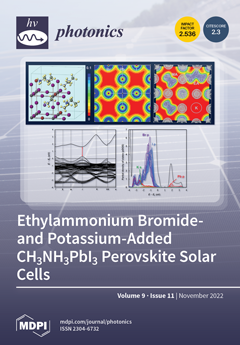Open AccessArticle
Photodetector Based on Twisted Bilayer Graphene/Silicon Hybrid Slot Waveguide with High Responsivity and Large Bandwidth
by
Siqi Yan, Ze Zhang, Weiqin Wang, Ziwen Zhou, Wenyi Peng, Yifan Zeng, Yuqin Yuan, Siting Huang, Xuchen Peng, Xiaolong Zhu, Ming Tang and Yunhong Ding
Cited by 4 | Viewed by 1667
Abstract
Graphene/silicon hybrid photodetector operating at communication wavelength has attracted enormous attention recently due to its potential to realize bandwidth larger than 100 GHz. However, the responsivity is intrinsically limited by the low absorption from the atomic-thick graphene monolayer, which imposes significant obstacles towards
[...] Read more.
Graphene/silicon hybrid photodetector operating at communication wavelength has attracted enormous attention recently due to its potential to realize bandwidth larger than 100 GHz. However, the responsivity is intrinsically limited by the low absorption from the atomic-thick graphene monolayer, which imposes significant obstacles towards its practical application. Although plasmonic structures has been widely applied to enhance the responsivity, it may induce the metallic absorption thus limit the responsivity lower than 0.6 A/W. Twisted bilayer graphene (TBG) has been reported to hold the ability to dramatically enhance the optical absorption due to the unique twist-angle-dependent van Hove singularities. In this article, we present a design of a silicon/TBG hybrid photodetector with a responsivity higher than 1 A/W and bandwidth exceeding 100 GHz. The enhanced responsivity is achieved by tuning the twisted angle of TBG to increase the absorption within the 1550 nm as well as utilizing the silicon slot waveguide to boost the mode overlap with TBG. The fabrication process of proposed design is also discussed demonstrating the advantages of low fabrication complexity. The proposed silicon/TBG photodetector could not only exhibit superior performance compared to previously reported silicon/monolayer graphene photodetector, but also pave the way for the practical application of graphene-based silicon optoelectronic devices.
Full article
►▼
Show Figures





